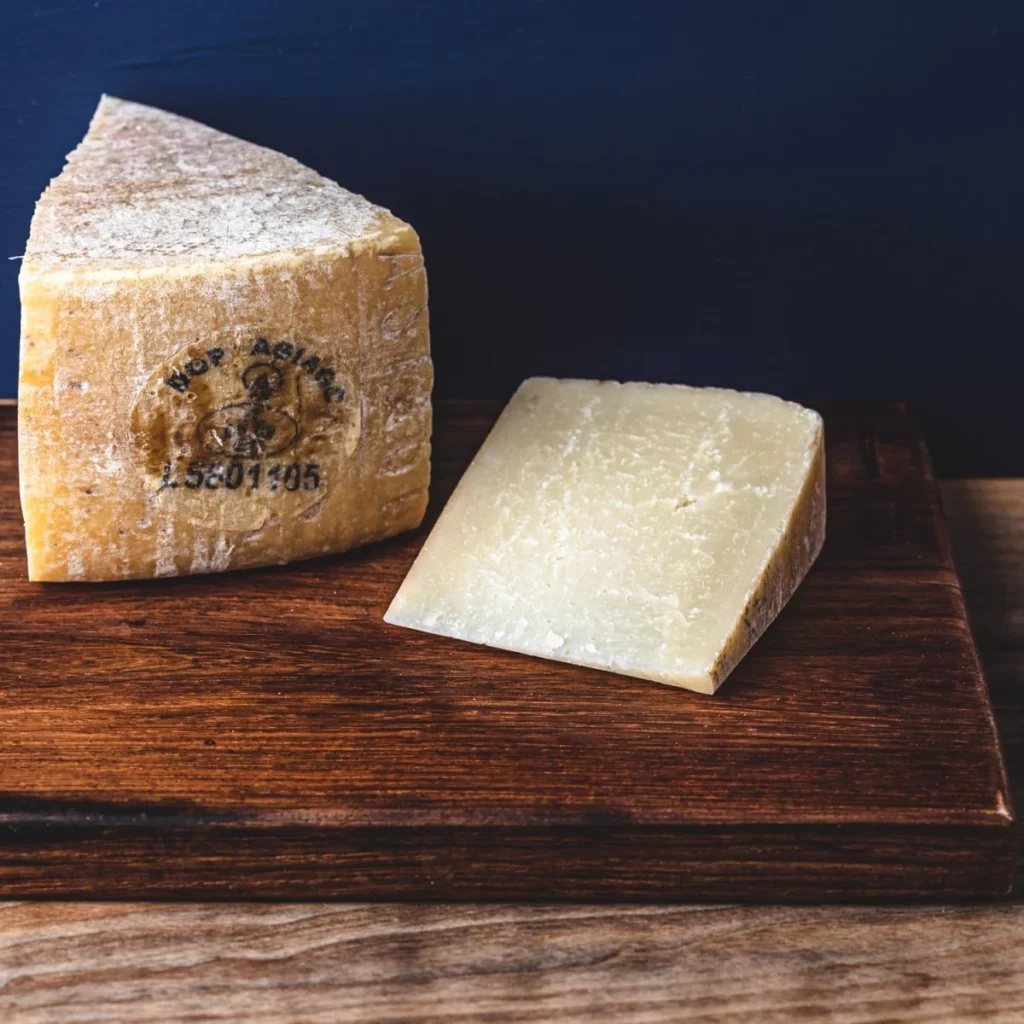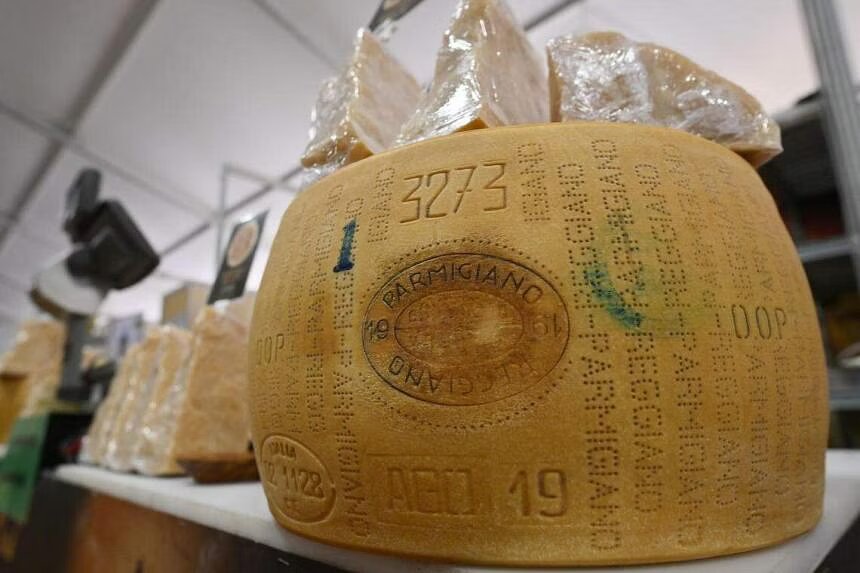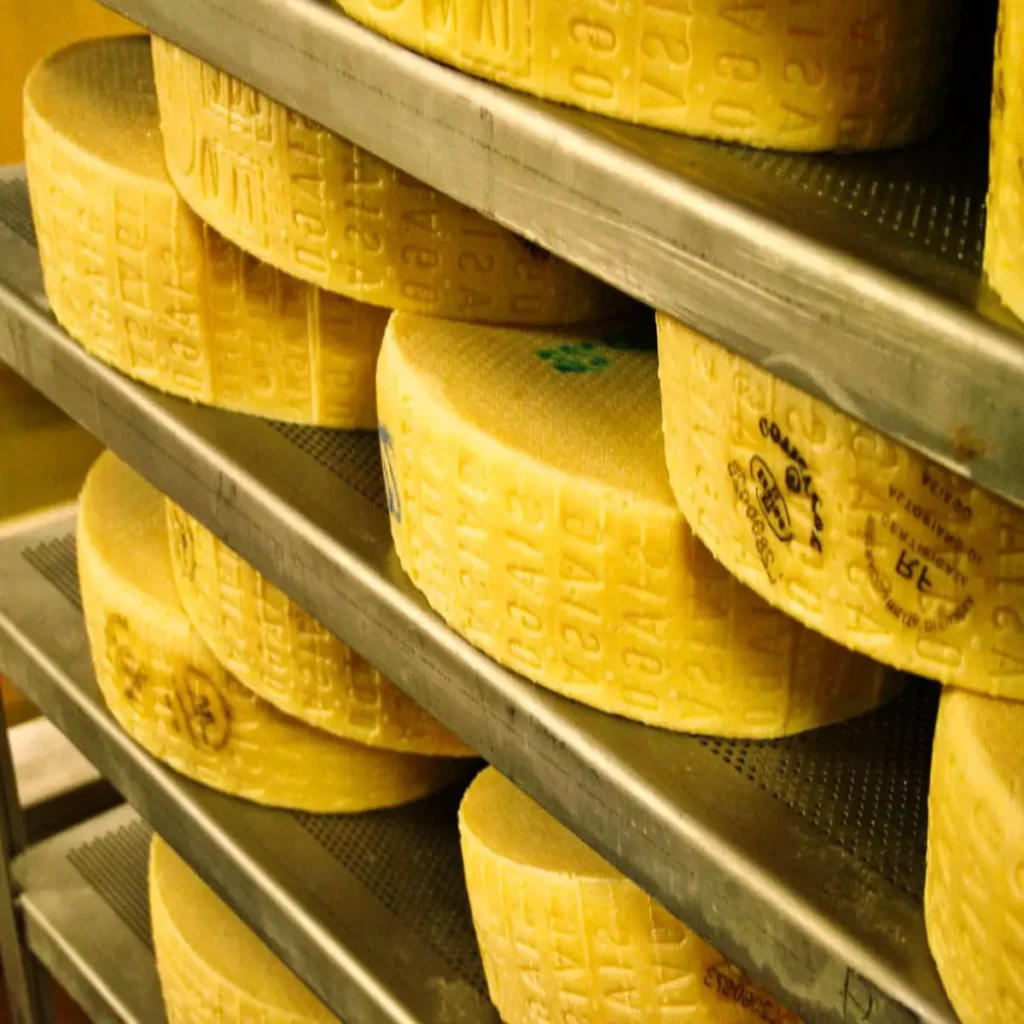Asiago Cheese: An In-depth Exploration of Nutrition and Taste

In the vast and varied world of cheese, there’s something both comforting and tantalizing about Asiago. This semi-hard Italian cheese has a rich history, a unique flavor profile, and an impressive nutrient content that makes it stand out among its dairy counterparts.
In this post, we will embark on a delicious journey of discovery, exploring the captivating realms of Asiago cheese.
From the gentle slopes of the Italian Alps where it was born, to the science behind its distinctive taste and impressive nutrition profile, we will delve into everything that makes Asiago more than just another cheese. Whether you’re a dedicated cheese connoisseur or a curious foodie, prepare to have your taste buds enlightened and your cheese knowledge expanded.
Quick facts about Asiago
| Quick Facts About Asiago | Details |
|---|---|
| Origin | Asiago is a cheese that originates from Italy, specifically from the Asiago Plateau in the Veneto foothills. |
| Type of Milk | This cheese is traditionally made from cow’s milk. |
| Aging Process | Asiago can be categorized into two types based on the aging process: Asiago Pressato (fresh Asiago) which is aged for 20-40 days and Asiago d’Allevo (mature Asiago) which is aged for 2-9 months or more. |
| Texture | The texture varies depending on its age. Young Asiago has a smooth, creamy texture while mature Asiago is firmer and crumblier. |
| Taste | Young Asiago has a sweet, slightly tangy flavor. As it ages, the taste becomes more savory and complex, with a nutty and yeasty undertone. |
| Nutritional Value | Asiago is a good source of protein and calcium, and it also contains vitamins A, B2, and B12. |
| Uses in Cuisine | Asiago cheese can be used in a variety of dishes, including pasta, risotto, salads, and sandwiches. It is also a popular choice for grating over dishes or melting into sauces. |
| Shelf Life | If stored properly in the refrigerator, Asiago cheese can last for several weeks. |
What is Asiago?
Asiago cheese is a cow’s milk cheese that originates from Italy, specifically the Asiago Plateau in the region of Veneto. It’s named after this area and has been produced there for hundreds of years.
There are two main varieties of Asiago based on its aging process: Asiago Pressato which is a fresh cheese, and Asiago d’Allevo, a mature cheese. Asiago Pressato is semi-soft, mild in flavor, and has a smooth texture. It’s aged for a short period of about 20 to 40 days. On the other hand, Asiago d’Allevo is firmer and crumblier with a more intense flavor. It’s aged for anywhere from 2 months to 2 years or even longer.
Asiago cheese has a pale yellow color and a natural rind. The flavor profile can range from sweet and slightly tangy when it’s young, to savory, full-bodied, and slightly sharp when it’s aged. This versatile cheese is used in a variety of dishes, including pasta, risotto, salads, and sandwiches. It’s also a popular choice for grating over dishes or melting into sauces.
Also read: What is the Best Cheese for Pizza?
What does Asiago taste like?
The taste of Asiago cheese can vary greatly depending on its age.
| Asiago Type | Texture | Flavor | Description | Ideal Use |
|---|---|---|---|---|
| Young Asiago (Asiago Pressato) | Semi-soft | Mild, sweet, slightly tangy | Often described as having a buttery or fruity taste. | Perfect for snacking or for use in lighter dishes such as salads. |
| Aged Asiago (Asiago d’Allevo) | Firmer | Robust, savory, complex | Develops nutty, yeasty, and slightly sharp undertones as it matures. The flavors become more pronounced the longer it is aged. | Ideal for grating over pasta, risotto, and other hearty dishes. |
Overall, Asiago is known for its rich, full-bodied flavor that adds depth to a variety of culinary creations.
Asiago tasting notes
Young Asiago (Asiago Pressato):

- Appearance: Semi-soft with a pale yellow color. The rind is thin and elastic, sometimes with a slight pink hue. The paste (interior) is homogeneous and lacks holes.
- Aroma: Mild and fresh with hints of yogurt and warm milk. There might be a slight scent of dried fruit and hay.
- Taste: Sweet and slightly tangy at the beginning, often described as having a buttery or fruity note. The finish is delicately creamy with a hint of acidity.
- Texture: Smooth and supple. It has a pleasing mouthfeel that’s not too heavy.
Aged Asiago (Asiago d’Allevo):

- Appearance: Harder and more compact compared to its younger counterpart. The color ranges from straw-yellow to brownish, depending on the aging period. The rind is tough and thick.
- Aroma: More pronounced with hints of toasted nuts, fermented yeast, and a whiff of barnyard. The scent becomes more complex as the cheese ages.
- Taste: Starts off with a savory, full-bodied flavor, developing into nutty, yeasty, and slightly sharp undertones. The taste profile becomes more robust and complex over time.
- Texture: Crumbly and grainy, especially when aged over ten months. The texture in the mouth is rich and satisfying.
Is Asiago the same as Parmesan?
While Asiago and Parmesan are both Italian cheeses, they are not the same and have distinct differences in their taste, texture, and aging process.
| Aspect | Asiago | Parmesan |
|---|---|---|
| Origin | From the Asiago Plateau in the Veneto foothills, Italy. | From the Emilia-Romagna and Lombardy regions of Italy. |
| Types | Asiago Pressato (Young, semi-soft), Asiago d’Allevo (Aged, harder). | Always sold aged with a minimum of 12 months, often much longer. |
| Appearance | Pale yellow to straw-yellow or brownish depending on aging. Young Asiago has a thin, elastic rind while aged Asiago has a tough, thick rind. | Golden yellow with a hard, thick rind. |
| Texture | Young Asiago is semi-soft and smooth. Aged Asiago is harder and can be crumbly. | Hard and grainy. |
| Flavor | Young Asiago is sweet and slightly tangy. Aged Asiago has a robust, savory flavor with nutty undertones. | Complex, fruity/nutty taste with a deep umami flavor. |
| Ideal Use | Young Asiago is perfect for snacking or in lighter dishes. Aged Asiago is ideal for grating over pasta, risotto, and other hearty dishes. | Often grated over pasta, used in soups and risottos, or eaten on its own as a snack. |
Asiago:

This cheese originates from the Asiago Plateau in the Veneto foothills in Italy. It can be sold as fresh Asiago (Asiago Pressato) which is semi-soft and sweet, or mature Asiago (Asiago d’Allevo) which is harder and has a more robust flavor. The aged version is often compared to Parmesan but it typically has a smoother texture and a more tangy, nutty flavor.
Parmesan (Parmigiano-Reggiano):

Arguably the king of Italian cheeses, Parmesan is made in the Emilia-Romagna and Lombardy regions of Italy. It’s always sold aged, with a minimum of 12 months, but often much longer. Parmesan has a hard, grainy texture and a complex fruity/nutty taste. It’s renowned for its deep umami flavor.
>> Click here to read our in-depth guide on Parmesan
While you can substitute one for the other in recipes, they are not the same cheese and each brings its unique characteristics to dishes.
What is special about Asiago cheese?
Asiago cheese has 5 unique characteristics that set it apart from other cheeses:
- Origin: Asiago cheese comes from a specific geographic region – the Asiago Plateau in the Veneto foothills in Italy. The cheese is named after this region, and its production is regulated by Italian law to ensure consistency and quality.
- Versatility: Asiago can be enjoyed both fresh (Asiago Pressato) and aged (Asiago d’Allevo). This versatility means it can be used in a variety of dishes. The fresh version is more delicate and sweet, perfect for sandwiches or melting into a sauce, while the aged version is hard and robust, ideal for grating over pasta, risotto, or soup.
- Flavor profile: Asiago cheese has a distinct flavor profile. Fresh Asiago has a mild, sweet, and slightly tangy taste with a creamy texture. As it ages, the flavor becomes more intense and complex, developing savory, nutty undertones.
- Protected Designation of Origin (PDO): Asiago is a PDO product. This means that only cheese produced in certain provinces of Italy following a specific process can be labeled as Asiago. This ensures that you’re getting a product that meets high standards of production and quality.
- Nutritional Value: Asiago is rich in protein and calcium, making it a nutritious addition to your diet. It also contains probiotics which are beneficial for gut health.
What is Asiago cheese similar to? 7 best substitutes
| Substitute | Origin | Texture | Flavor | Best Use | Why it’s a Good Substitute |
|---|---|---|---|---|---|
| Grana Padano | Italy | Hard and grainy | Mildly flavored, slightly sweet and savory | Grating over pasta or risotto, used in soups | Similar granular texture and Italian origin as Asiago |
| Parmigiano Reggiano (Parmesan) | Italy | Hard and crumbly | Nutty and fruity with a deep umami flavor | Grating over dishes, used in soups and risottos, or eaten as a snack | Both are dry, aged, white cheeses with a similar profile |
| Pecorino Romano | Italy | Hard and crumbly | Strong and salty | Grating over pasta, risotto | Top contender for grating substitute due to its unique flavor |
| Gruyere | Switzerland | Hard | Slightly sweet, nutty | Melting in dishes, topping for gratins, in sandwiches | Shares similarities with Asiago in terms of its slightly sweet, nutty flavor and smooth texture |
| Manchego | Spain | Semi-hard | Intense, slightly salty | Eaten as a snack, in sandwiches, grated over dishes | One of the top high-quality substitutes for Asiago cheese |
| Provolone | Italy | Semi-hard | Mild to sharp, depending on age | Melting in sandwiches, pizza | This Italian cheese is also made from cow milk and can be used easily in sandwiches |
| Nutritional Yeast or Vegan Nut-based Cheeses | Various | Varies | Savory, cheesy | Vegan alternative for grating over pasta, risotto | For those who are vegan or lactose intolerant, these can provide a similar flavor profile |
Is Asiago healthy?
Yes, Asiago cheese is considered healthy and nutrient-rich. It provides several health benefits due to its high content of protein, calcium, and other essential nutrients.
- Protein: Asiago is a good source of protein. Protein is vital for building and repairing tissues in your body.
- Calcium: Asiago cheese is an excellent source of calcium, which is crucial for bone and teeth health. A 1-ounce serving of Asiago cheese provides about 20 percent of the daily recommended intake of calcium.
- Calories: One ounce of Asiago cheese contains approximately 100 calories. The calorie breakdown is roughly 72% fat, 0% carbs, and 28% protein.
- Fat and Sodium: Asiago cheese does contain saturated fats and sodium. A 1-ounce (28g) serving provides 18 g of saturated fats and 1214 g of sodium. While these components should be consumed in moderation, they are part of a balanced diet.
Note: while Asiago cheese is healthy, like all foods, it should be consumed in moderation as part of a balanced diet.
Asiago nutrition facts
| Nutrient | Amount (per 1 ounce/28g) |
|---|---|
| Calories | 100-130 |
| Total Fat | 11g |
| Cholesterol | 30mg |
| Sodium | 310-1214mg |
| Total Carbs | 0-0.9g |
| Protein | 7g |
What pairs well with Asiago?

Food that goes well with Asiago
| Category | Foods |
|---|---|
| Fruits | Apples, Pears, Grapes |
| Vegetables | Spinach, Tomatoes, Bell Peppers |
| Meats | Prosciutto, Salami, Chicken |
| Seafood | Shrimp, Salmon, Lobster |
| Breads | Baguette, Sourdough, Whole Grain Bread |
| Nuts & Seeds | Almonds, Walnuts, Sunflower Seeds |
| Condiments | Olive Oil, Honey, Balsamic Vinegar |
| Pasta & Grains | Penne, Farfalle, Quinoa |
| Desserts | Dark Chocolate, Fruit Tarts, Cheesecake |
Also read: What Fruit Goes on a Charcuterie Board?
Beverage that goes well with Asiago
| Category | Beverages |
|---|---|
| Wines | Chardonnay, Pinot Grigio, Cabernet Sauvignon |
| Beers | Pale Ale, Lager, Wheat Beer |
| Spirits | Brandy, Whiskey, Gin |
| Non-Alcoholic | Sparkling Water, Apple Cider, Grape Juice |
Also read: Best Wine and Cheese Pairings: The Ultimate Guide
The History of Asiago

Asiago cheese has a rich and storied history. Its origins trace back to the Asiago Plateau in the Veneto foothills of Italy, where it is still produced today under the protected designation of origin (DOP) certification. This certification ensures that Asiago cheese is made following strict traditional methods and only on the Asiago Plateau.
The earliest mentions of Asiago cheese in writing date back to the 10th century. By the 15th century, it had become a staple in Italian cuisine. The cheese was introduced into the United States by Italian immigrants in the 1920s and gained popularity in the late 20th and early 21st centuries.
The Asiago region, in addition to being known for its cheese, has historical significance as well. It was the site of a major battle between Austrian and Italian forces during World War I. Today, aside from cheese production, it’s also a major ski resort destination.
The cheese itself is a whole milk cheese that originated around the Po River Valley near the Trentino Alto Adige region, where Italy borders Austria. Over time, Asiago has become one of the most appreciated Italian cheeses worldwide.
Frequently Asked Questions
1. Is Asiago cheese tasty?
Asiago is generally described as having a strong and nutty flavor. It’s semi-hard with a rich, creamy texture.
The taste can vary depending on its aging period. Fresh Asiago (Asiago Pressato) is smoother and milder, while mature Asiago (Asiago d’allevo) has a more robust flavor, similar to Parmesan. It’s often enjoyed on its own, grated over dishes, or melted in cooking due to its excellent melting properties.
2. Does Asiago cheese melt like Mozzarella?
Asiago cheese does melt, but not quite in the same way as mozzarella. Mozzarella is known for its exceptional melting qualities, becoming stretchy and stringy when heated, which makes it a favorite for dishes like pizza and lasagna.
Asiago, on the other hand, melts in a slightly different fashion. Fresh Asiago (Asiago Pressato), due to its higher moisture content, tends to melt quite well and can be used in much the same way as mozzarella. It becomes creamy and smooth when melted, but it doesn’t have the same stretchiness as mozzarella.
Aged Asiago (Asiago d’allevo), however, has a lower moisture content and a harder texture, so it doesn’t melt as easily. When it does melt, it won’t become as creamy or stretchy as fresh Asiago or mozzarella.
Instead, it’s often grated and used to add flavor to dishes in the same way you might use Parmesan.
3. Is Asiago cheese good for pizza?
Yes, Asiago cheese can be an excellent choice for pizza. It’s known for its sharp, slightly nutty flavor which can add a unique taste to your pizza. Fresh Asiago, or Asiago Pressato, melts well and can provide a smooth, creamy texture to the pizza.
While Asiago may not melt as stringy as Mozzarella, it can still contribute a delightful flavor and texture. It’s often used in combination with other cheeses like Mozzarella or Parmesan to create a more complex flavor profile.
Remember, the type of cheese you use can significantly affect the taste of your pizza, so feel free to experiment with different combinations to find the one that suits your palate the best.
4. How to pronounce Asiago?
Asiago is pronounced as “ah-see-AH-go”. Here’s a breakdown:
- “ah” as in the ‘a’ in ‘father’
- “see” as in ‘see’
- “AH” as in the ‘o’ in ‘hot’
- “go” as in ‘go’
Remember, the emphasis is on the third syllable – AH. So, it’s “ah-see-AH-go”.
Also read:
- Menonita Cheese: A Staple in Northern Mexican Cuisine
- All About Roquefort: An Insider’s Guide to the King of Blue Cheese
- The Ultimate Guide to Bocconcini: From Origin to Plate
- The Ultimate Guide to Muenster Cheese: Savor the Flavor
- Ricotta Guide: All You Need to Know About This Versatile Cheese
- The Ultimate Guide to Chèvre: Exploring Goat Cheese
- The Ultimate Guide to Kasseri: A Taste of Tradition





